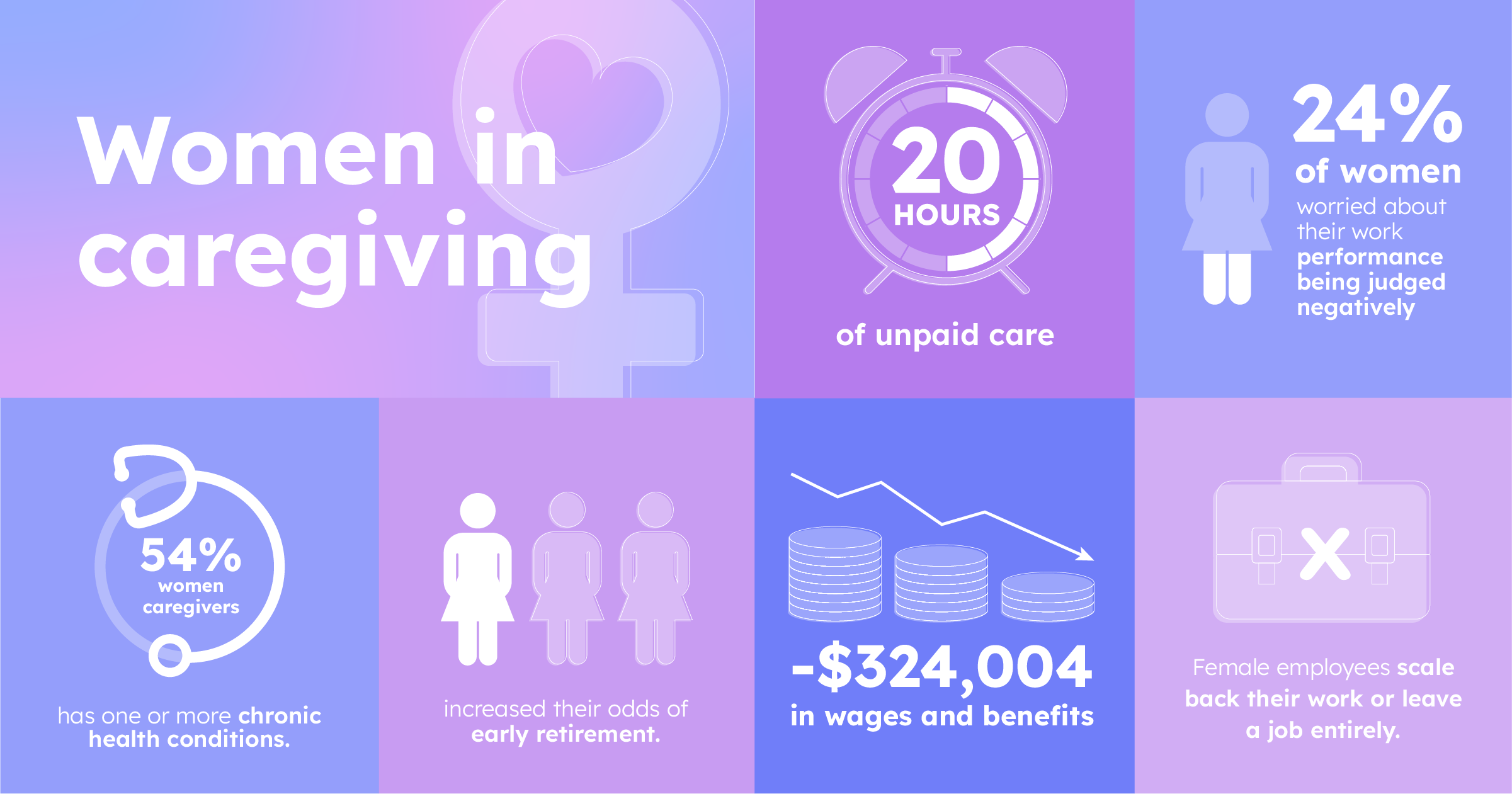Women have been the face of caregiving for generations, all while enduring many challenges like sexism, poverty, and inequality. We honor their sacred journey and the influence they’ve had on society through their sacrifices. Get to know the average woman's caregiving experience by reading the following facts and statistics.

Women as Primary Caregivers Overview
- The average caregiver is a 49-year-old woman providing 20 hours of unpaid care a week to a parent. These “working daughters” are employed and in the sandwich generation. Twenty-six percent of them are parents of a minor, and more than 50% financially support an adult child.
- The majority of family caregivers remain women, and they provide more hours of care than their male counterparts. An estimated 59% of women provide 20 hours or less of unpaid care per week compared to 41% of men. The difference between male and female caregivers providing more hours of unpaid care is much greater: 62% of women provide more than 20 hours of weekly care compared to 38% of men.
- Before and throughout the COVID-19 pandemic, family caregiving responsibilities have fallen mostly on women. One in 10 women reported caring for a family member prior to the pandemic, and also one in 10 women shared they gained new caregiving responsibilities as a result of the pandemic.
- BIPOC women providing care are twice as likely as white women caregivers to only have a high school education or less.
Women’s Financial Health and Caregiving
- More women caregivers are reporting a lack of choice to provide care — 55% in 2020 compared to 50% in 2015. They are also more likely than men to care for two or more adults, to be unemployed, and to be more stressed.
- Since the start of the pandemic, three million American women have left the workforce. An inability to adequately balance caregiving responsibilities and work responsibilities may be to blame.
- Dropping down to part-time employment or leaving the workforce altogether can put women caregivers in a precarious financial situation, especially as they reach retirement age.
- A study published in 2016 found that nearly one in three working women providing ongoing and intensive caregiving increased their odds of early retirement as a result of their caregiving responsibilities which had a significant impact on their income in retirement.
- Fewer hours worked and lost wages due to caregiving earlier in life makes women caregivers two-and-a-half times more likely than non-caregivers to experience poverty later in life.
- Studies show women age 50 and older who leave their employment to care for a parent lose, on average, nearly $324,004 in wages and benefits over their lifetime.
Women’s Physical & Mental Health and Caregiving
- Caregiving can contribute to declines in health. Fifty-four percent of women caregivers are managing one or more chronic health conditions compared to 41% of non-caregiving women. This same study also found that women caregivers spending nine or more hours a week caring for a spouse double their risk for coronary heart disease.
- Women who identify as caregivers have higher rates of emotional distress than non-caregivers, often two to three times higher.
- A study showed that women caring for a spouse or children were more likely to experience adverse effects to their mental health. For men in the same care situation, overall mental health was not adversely affected.
Access to Caregiving Resources for Women Caregivers
- Non-white women typically face greater challenges accessing paid sources for caregiving. Thirty percent of Black and 40% of Hispanic single women aged 65 years or older live in poverty.
- According to a study on informal caregivers in New York City, the majority of participants in the study were women and shared one of the highest unmet needs was respite care. At least one in four caregivers needs it and does not receive it. In this same study, it was found that the top two most prevalent barriers to obtaining services are lack of knowledge about available services and having income/financial limitations.
Women and the Workforce
- In their 2020 Women in the Workplace study, McKinsey & Company and LeanIn.org found that certain challenges, like taking on more caregiving responsibilities through the pandemic, are common reasons why women employees scale back their work or leave a job entirely.
- This same report found that 24% of women worried about their work performance being judged negatively as a result of their caregiving.
- The Great Resignation, which refers to the phenomenon of people leaving their jobs through and after the pandemic, may be affecting more women than men. According to the National Women's Law Center, based on data collected from the U.S. Bureau of Labor Statistics, found that September 2021 saw the biggest drop in women’s labor force participation since the year prior.
- This same press release states that, "309,000 women ages 20 and over left the labor force entirely" in September 2021. According to CNBC, reasons for leaving a job include burnout and child- and elder-care responsibilities.
By making a conscious efforts to ease the burden on women caregivers, their caregiving journey can improve. There are easy, free ways you can support a woman caregiver in your life. Check out our guide on ways to support a caregiver. To learn more about what makes the women’s caregiving experience unique, read 4 Essential Qualities of Women Caregivers.
UPDATED FEBRUARY 2022
